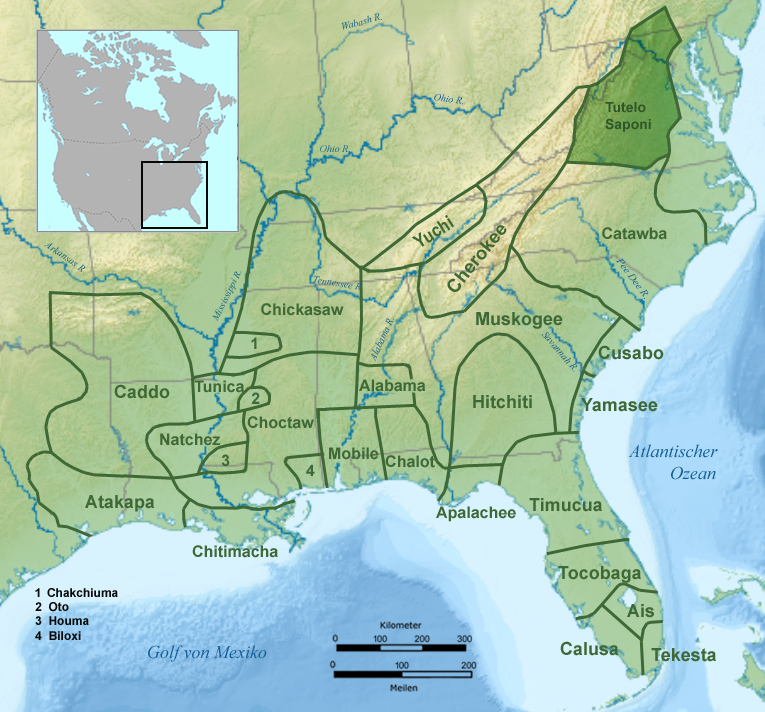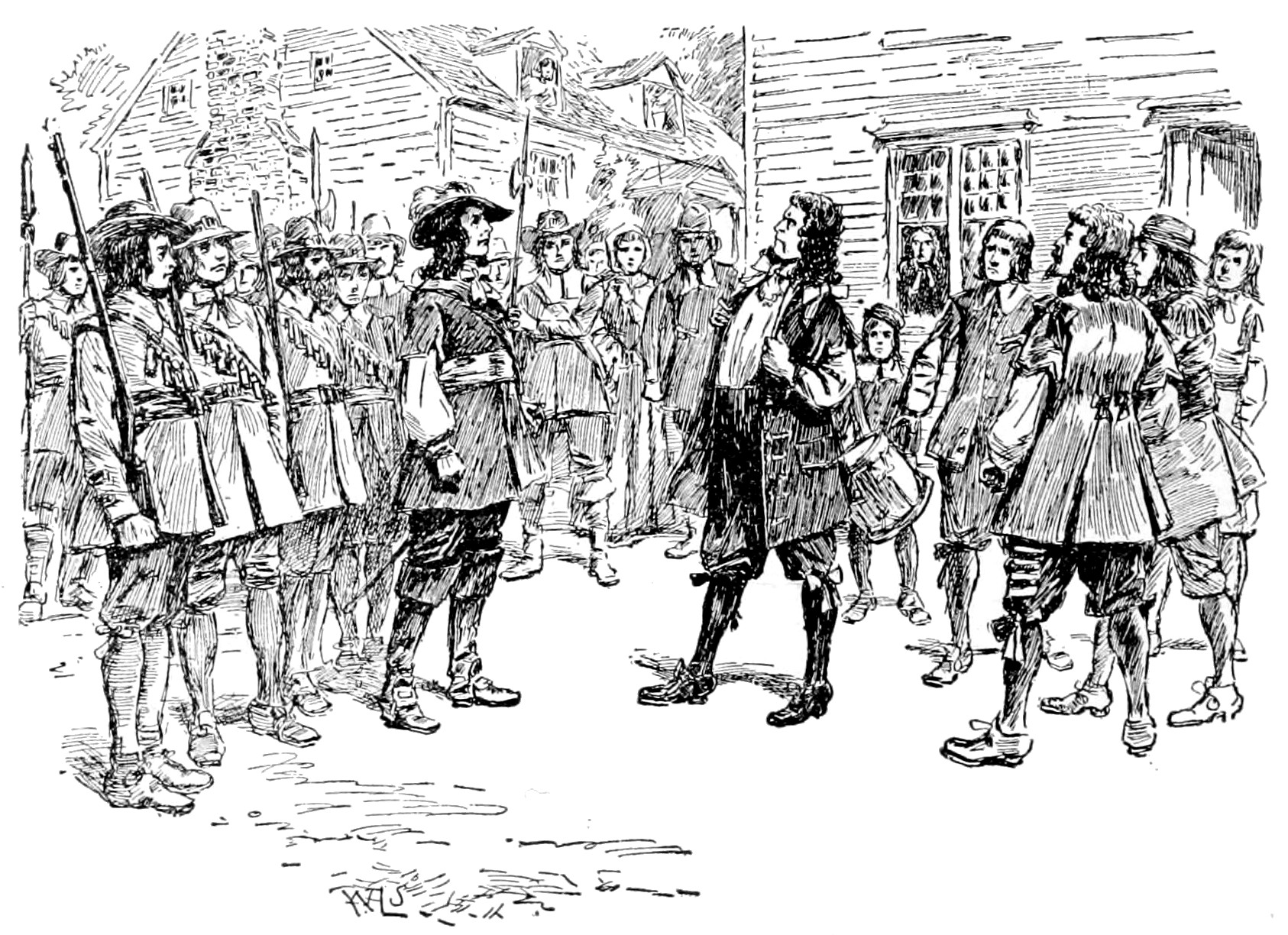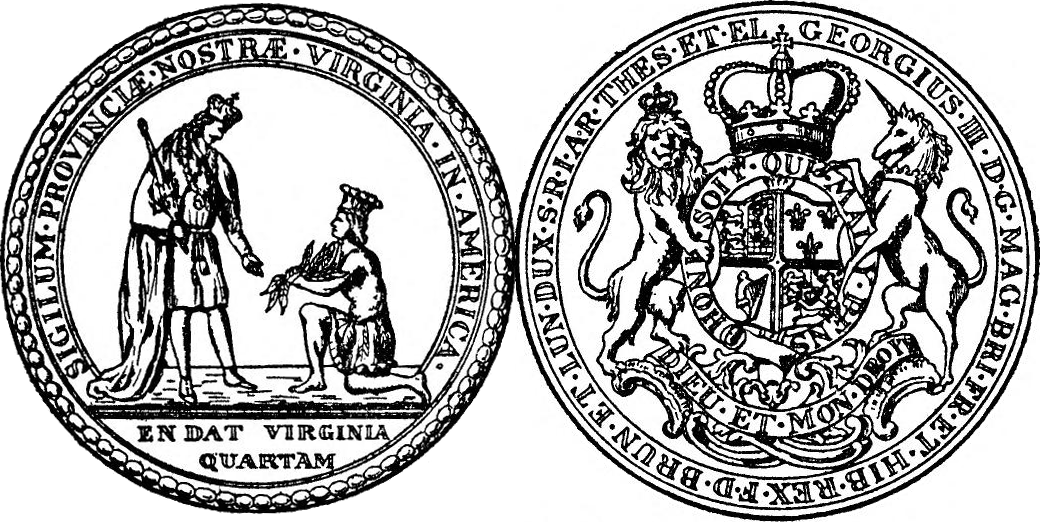|
Occaneechi
The Occaneechi (also Occoneechee and Akenatzy) are Native Americans who lived in the 17th century primarily on the large, long Occoneechee Island and east of the confluence of the Dan and Roanoke rivers, near current-day Clarksville, Virginia. They spoke one of the Siouan languages, and thus related to the Saponi, Tutelo, Eno and other Southeastern Siouan-language peoples living in the Piedmont region of present-day North Carolina and Virginia. In 1676, in the course of Bacon's Rebellion, the tribe was attacked by militias from the Colony of Virginia and decimated. Also under demographic pressure from European settlements and newly introduced infectious diseases, the Saponi and Tutelo came to live near the Occaneechi on adjacent islands. By 1714 the Occaneechi moved to join the Tutelo, Saponi, and other Siouan people living on a reservation in current-day Brunswick County, Virginia. It included a fort called Christanna. The Siouan people had been drastically reduced to approx ... [...More Info...] [...Related Items...] OR: [Wikipedia] [Google] [Baidu] |
Occaneechi Band Of The Saponi Nation
The Occaneechi Band of the Saponi Nation are a state-recognized tribe in North Carolina. They were previously named the Eno Occaneechi Indian Association but changed their name in 1994. They claim descent from the historic Occaneechi, Saponi, and other Eastern Siouan language-speaking Indians who occupied the Piedmont of North Carolina and Virginia. The tribe maintains an office in Mebane, where it carries out programs to benefit the roughly 1,100 enrolled tribal members. Historical tribes Limited documentation exists linking members of the tribe to the historical Occaneechi and Saponi tribes. After warfare in the Southeast in the 18th century, most of the remaining Saponi tribe members went north in 1740 for protection with the Haudenosaunee. After the American Revolution, they relocated with the Iroquois in Canada, as they had been allies of the British. After the war and migration, the Saponi disappeared from the historical record in the Southeast, in part because of racial ... [...More Info...] [...Related Items...] OR: [Wikipedia] [Google] [Baidu] |
Saponi
The Saponi or Sappony are a Native American tribe historically based in the Piedmont of North Carolina and Virginia.Raymond D. DeMaillie, "Tutelo and Neighboring Groups," pages 286–87. They spoke a Siouan language, related to the languages of the Tutelo, Biloxi, and Ofo. Since the mid-20th century, certain groups in the Southeast have organized to assert their American Indian cultural identity; some claim descent from the historic Saponi. Three state-recognized tribes in North Carolina, the Haliwa-Saponi Indian Tribe, the Occaneechi Band of the Saponi Nation, and the Sappony (formerly known as the Indians of Person County until 2003) all identify as Saponi. None of these organizations are federally recognized as a Native American tribe. Etymology The origin and meaning of ''Saponi'' is debated. Ethnographer James Mooney suggested the word might come from the Siouan term ''sapa'' meaning "black." German explorer John Lederer suggested their name came from Sepy, a female immo ... [...More Info...] [...Related Items...] OR: [Wikipedia] [Google] [Baidu] |
Tutelo
The Tutelo (also Totero, Totteroy, Tutera; Yesan in Tutelo) were Native Americans in the United States, Native American people living above the Atlantic Seaboard fall line, Fall Line in present-day Virginia and West Virginia. They spoke a Siouan dialect of the Tutelo language thought to be similar to that of their neighbors, the Monacan (tribe), Monacan and Manahoac nations. Under pressure from English settlers and Seneca people, Seneca Iroquois, they joined with other Virginia Siouan tribes in the late 17th century and became collectively known as the Nahyssan. By 1740, they had largely left Virginia and migrated north to seek protection from their former Iroquois opponents. They were adopted by the Cayuga people, Cayuga tribe of New York (state), New York in 1753. Ultimately, their descendants migrated into Canada. Name The English name ''Tutelo'' comes from the Algonquian variant of the name that the Iroquois used for all the Virginia Siouan tribes: Toderochrone(many variant s ... [...More Info...] [...Related Items...] OR: [Wikipedia] [Google] [Baidu] |
Bacon's Rebellion
Bacon's Rebellion was an armed rebellion held by Colony of Virginia, Virginia settlers that took place from 1676 to 1677. It was led by Nathaniel Bacon (Virginia colonist), Nathaniel Bacon against List of colonial governors of Virginia, Colonial Governor William Berkeley (governor), William Berkeley, after Berkeley refused Bacon's request to drive Native Americans out of Virginia. Thousands of Virginians from all Social class in the United States, classes (including those in Indentured servitude in British America, indentured servitude) and Race and ethnicity in the United States, races rose up in arms against Berkeley, chasing him from Jamestown, Virginia, Jamestown and ultimately torching the settlement. The rebellion was first suppressed by a few armed merchant ships from London whose captains sided with Berkeley and the Loyalism, loyalists. Government forces arrived soon after and spent several years defeating pockets of resistance and reforming the colonial government to b ... [...More Info...] [...Related Items...] OR: [Wikipedia] [Google] [Baidu] |
Occaneechi Language
Tutelo, also known as Tutelo–Saponi, is a member of the Virginian branch of Siouan languages that were originally spoken in the territory now known as Virginia and West Virginia in the United States. Some speakers of Tutelo migrated north to escape warfare. Traveling through North Carolina, Pennsylvania, New York, they finally settled in Ontario after the American Revolutionary War with the Cayuga (Iroqouian speakers) at what is now known as Six Nations of the Grand River First Nation. Nikonha, the last fluent speaker in Tutelo country, died in 1871 at age 106. The year before, he had managed to impart about 100 words of vocabulary to the ethnologist Horatio Hale, who had visited him at the Six Nations Reserve.Horatio Hale"Tutelo Tribe and Language" ''Proceedings of the American Philosophical Society'' 21, no. 114 (1883) In 1753 the Tutelo had joined the Iroquois confederacy under the sponsorship of the Cayuga. Descendants living at Grand River spoke Tutelo well into the twe ... [...More Info...] [...Related Items...] OR: [Wikipedia] [Google] [Baidu] |
Alamance County, North Carolina
Alamance County (), from the North Carolina Collection's website at the University of North Carolina at Chapel Hill. Retrieved September 18, 2012. is a county in North Carolina. As of the 2020 census, the population was 171,415. Its county seat is Graham. Formed in 1849 from Orange County to the east, Alamance County has been the site of significant historical events, textile manufacturing, and agriculture. Alamance County comprises the Burlington Metropolitan Statistical Area, which is also included in the Greensboro–Winston-Salem– High Point Combined Statistical Area. The 2018 estimated population of the metropolitan area was 166,436. History Before being formed as a county, the region had at least one known small Southeastern tribe of Native Americans in the 18th century, the Sissipahaw, who lived in the area bounded by modern Saxapahaw, the area known as the Hawfields, and the Haw River. European settlers entered the region in the late 17th century chiefly following ... [...More Info...] [...Related Items...] OR: [Wikipedia] [Google] [Baidu] |
Eno (people)
The Eno or Enoke, also called Stuckenock, was an American Indian tribe located in North Carolina during the 17th and 18th centuries that was later absorbed into the Catawba tribe in South Carolina along with various other smaller tribal bands. Name While the exact meaning of the Eno people's name is unknown, the anthropologist Frank Speck suggested the synonym ''Haynokes'', as recorded by Francis Yeardley in 1654, could relate the meaning to ''i'nare'', "to dislike" or ''yeⁿni'nare'', "people disliked". Linguist Blair A. Rudes later alternatively proposed that Eno derives from ''ènu'', the Catawba word for "little crow". History The Enos were first mentioned in historic documents by William Strachey (the first secretary of the colony of Virginia) in his early-17th century book ''The Historie of Travaile Into Virginia Britannia''. Strachey mentions the "Anoeg" to the southwest of the Powhatan Confederacy (centered near present-day Richmond, Virginia) "whose howses are built a ... [...More Info...] [...Related Items...] OR: [Wikipedia] [Google] [Baidu] |
Roanoke River
The Roanoke River ( ) runs long through southern Virginia and northeastern North Carolina in the United States. A major river of the southeastern United States, it drains a largely rural area of the coastal plain from the eastern edge of the Appalachian Mountains southeast across the Piedmont to Albemarle Sound. An important river throughout the history of the United States, it was the site of early settlement in the Virginia Colony and the Carolina Colony. An section of its lower course in Virginia between the Leesville Lake and Kerr Lake is known as the Staunton River, pronounced , as is the Shenandoah Valley city of that name. It is impounded along much of its middle course to form a chain of reservoirs. Staunton River is also the name of the northern political district of Pittsylvania County, Virginia, where a large section of the river serves as the boundary between Campbell County, Virginia (to the north) and Pittsylvania County (to the south). The Roanoke River State T ... [...More Info...] [...Related Items...] OR: [Wikipedia] [Google] [Baidu] |
Colony Of Virginia
The Colony of Virginia, chartered in 1606 and settled in 1607, was the first enduring English colonial empire, English colony in North America, following failed attempts at settlement on Newfoundland (island), Newfoundland by Sir Humphrey GilbertGilbert (Saunders Family), Sir Humphrey" (history), ''Dictionary of Canadian Biography'' Online, University of Toronto, May 2, 2005 in 1583 and the colony of Roanoke (further south, in modern eastern North Carolina) by Sir Walter Raleigh in the late 1580s. The founder of the new colony was the Virginia Company, with the first two settlements in Jamestown, Virginia, Jamestown on the north bank of the James River and Popham Colony on the Kennebec River in modern-day Maine, both in 1607. The Popham colony quickly failed due to Starving Time, a famine, disease, and conflicts with local Native American tribes in the first two years. Jamestown occupied land belonging to the Powhatan Confederacy, and was also at the brink of failure before the arr ... [...More Info...] [...Related Items...] OR: [Wikipedia] [Google] [Baidu] |
Clarksville, Virginia
Clarksville is a town in Mecklenburg county in the U.S. state of Virginia, near the southern border of the commonwealth. The population was 1,139 at the 2010 census. Since the town has numerous buildings of the 18th-, 19th-, and early 20th-century architecture, the downtown area of Clarksville has been designated a Historic District on the National Register of Historic Places and Virginia's Historic Register. Clarksville claims the title of Virginia's only Lakeside town. Virginia's only Lakeside Town. Nearby the town of Clarksville is . The town is located on |
Edward Bland (explorer)
Edward Bland (died ca. 1653) was an English explorer and merchant. Bland was born in England to John and Susan Bland and was one of several children. He was baptized on February 5, 1614 in the Saint Stephen Coleman Street parish. Around 1634 Bland married his cousin Jane Bland, the daughter of his uncle, Gregory Bland. They had one child together, Edward. He was sent to Virginia in about 1646, by his older brother, John, to look after the family's land and mercantile interests there, following the death of their younger brother Adam. Once there he began to acquire more land and by 1652 owned a substantial amount on both sides of the James River. During the summer of 1650 Bland accompanied Abraham Woode, Sackford Brewster, Elias Pennant, and an Appamattoc guide named Pyancha on an expedition of lands to the south of Virginia. The group hoped to travel up the Roanoke River and surpass the terrain explored by Ralph Lane, but were unsuccessful. Bland kept a record of the journey, which ... [...More Info...] [...Related Items...] OR: [Wikipedia] [Google] [Baidu] |
Christanna
Fort Christanna was one of the projects of Lt. Governor Alexander Spotswood, who was governor of the Virginia Colony 1710–1722. When Fort Christanna opened in 1714, Capt. Robert Hicks was named captain of the fort and he relocated his family to the area. His homestead "Hick’s Ford" is close to the modern city of Emporia in Greensville County, VA. The fort was designed to offer protection and schooling to the tributary Siouan and Iroquoian tribes living to the southwest of the colonized area of Virginia. Located in what became Brunswick County, Virginia, near Gholsonville, the fort was completed in 1714 and enjoyed three successful years of operation as the westernmost outpost of the British Empire at the time, before being finally closed by the House of Burgesses in 1718. However, the Saponi and Tutelo continued to live on the allotted land, 6 miles square (36 sq. mi), into the 1730s and 1740s. Background After the Tuscarora War broke out in 1711, Spotswood conceived th ... [...More Info...] [...Related Items...] OR: [Wikipedia] [Google] [Baidu] |





